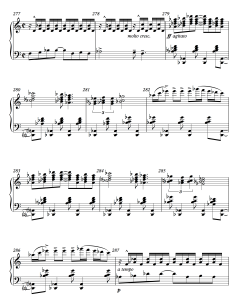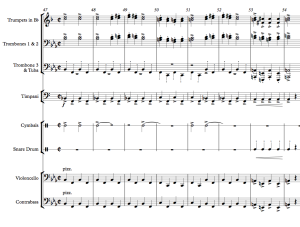Less is more.
Sometimes, perhaps often really, this platitude rings true.
Yet there are times when in fact more is more. In music, it’s hard to imagine Berlioz’s Symphonie fantastique, any Mahler symphony or Stravinsky’s Le Sacre du printemps arranged for string quartet.
Whether it was larger halls accommodating larger audiences requiring larger orchestras to fill the space or composers creating works for larger orchestras that required larger halls is an argument for another day. The fact is that orchestras grew dramatically in the nineteenth century. And with more resources at their disposal, composers found a variety of ways to exploit them.
In addition to layering and enhancing melodies and harmonies in the orchestra, composers in the nineteenth cenutry began to explore ways to use a greater variety of rhythms. Eventually multiple rhythms were written to be played simultaneously as counter-rhythms.
The last three posts have focused on rhythm and counter-rhythm. With this post the series will be wrapping up, for now at least. We have examined a range of syncopated melodies and rhythms in some of George Gershwin’s orchestral works as well as a few examples from Leonard Bernstein, plus a smattering of Beethoven, Berlioz and Bartók.
In most of these selected passages the composer created rhythm—usually in duple meter—but rhythm that is nonetheless regular. These rhythms are distinct and evident. The examples illuminate how the regular rhythms have been manipulated to throw off their regularity. Sometimes these irregular meters only display themselves with subtlety. Often, they trumpet their presence.
In addition to the energy these manipulations provide, there is the element of surprise. This can grab and hold the interest of an audience, especially when the listeners are trying to know when to tap their toes.
Syncopation for Solo Piano and for Orchestra
If you have been following the recent posts, you will recall the discussions of the mixture of arrangements and interpretations of George Gershwin’s Rhapsody in Blue. Regardless of the individuality of each performance (that was highlighted), the way the composer juxtaposes rhythms is evident frequently throughout the piece. Although we’ve heard examples that have been edited, when the piece is played as a basically complete performance, one section that is rarely cut out is the bridge that leads up to the slow and lush middle, E major, tune. This is the one with the octave drop after the first three ascending scalar quarter notes. (A section that has become synonymous with the advertising of a certain international airline.)
Example 62.1 George Gershwin: Rhapsody in Blue (277–287)
Eugene List, Howard Hanson, Eastman-Rochester Symphony Orchestra, Mercury Living Presence
Let’s begin with this solo piano part. Example 62.1 starts at measure 277, about a minute before the E major melody. Gershwin begins by playing one of the work’s motifs in the left hand and building tension with a tremolo in the right hand. After four bars of this (just two are shown in the example), the melody moves from the left to the right hand. But notice the left hand at measure 279. It begins eight measures of syncopated groups of three eighth beats (eighth note followed by quarter note). In addition to the obvious challenge for the soloist to quickly leap between the two octaves, this motif has a mostly steady 4/4 rhythm. This is juxtaposed against this counter-rhythm in triple meter.
Another passage in which Gershwin uses the same technique comes earlier in the work, but employs the same melody. Here, though, the counter-rhythm, still in triple meter, is only half the speed. Rather than taking up 3 eighth notes, it takes up 3 quarter notes. Listen to Example 62.2 and focus on the bass.
Example 62.2 George Gershwin: Rhapsody in Blue (157–165)
Eugene List, Erich Kunzel, Cincinnati Symphony Orchestra, Telarc
The rhythm in the low instruments (bassoons, low brass and low strings) consists of a descending pattern of three quarter notes that repeats through the passage. Hence, the accents are on the first beat of measure 157, the last beat of the measure, the third beat of the ensuing measure, and then second beat of measure 159. This pattern repeats in the next four measures.
The utility of such a shift in rhythms lies in its break from the tradition. Duple meter is nothing new. Hearing duple meter against a counter-rhythm spices up the rhythmic palate, giving the listener new and novel ideas, capturing the audiences attention.
Bernstein in three and four
Sometimes the music itself can be interpreted by changing bar lines and creating a hemiola. Look at the score and listen to a passage early in the Overture to Leonard Bernstein’s Candide in Example 62.3. I have typeset the music into triple meter. Note how it looks natural as a passage in 3/2. The accents appear to be on the downbeat of each measure. Yet, looks can be deceiving. As you listen there’s something “off” about the meter.
Example 62.3 Leonard Bernstein: Candide Overture (47–54) in triple meter
Leonard Bernstein, London Symphony Orchestra, Deutsche Grammophon
Keep the triple meter of the score in mind when listening to Example 62.4. Although the music is exactly the same, hear how this portion of the score (playing a section of the Act I “Battle Music”), previously notated in triple meter is now in cut time. This throws off the straight 2/2 that the audience was expecting when this passage began. Note that all the composer adds to emphasize the apparent shifting of rhythms is the cymbal on the triple meter’s first note.
Example 62.4 Leonard Bernstein: Candide Overture (47–54)
Leonard Bernstein, London Symphony Orchestra, Deutsche Grammophon
The reality is nevertheless clear: Just moving bar lines does not make a rhythm different. It may help, but for this passage the interest is built into the melody itself. Although it’s not discussed often, melodies have innate tendencies that give the listener a guide to what they have heard and what should or might be coming next. Arrangements and orchestrations can always assist in rhythmic modification, but melody usually provides its own guideposts.
Ever inventive, Bernstein also uses the extra beats in the form of moving between duple and triple time signatures. In fact, the familiar tune that recurs in the musical itself is presented in Example 62.4. After the descending staccato notes in the flute and clarinet (accented by bells and pizzicato strings) the melody begins at measure 83.
Example 62.5 Leonard Bernstein: Candide Overture (80–93)
Leonard Bernstein, London Symphony Orchestra, Deutsche Grammophon
This tune (based on the song “Oh Happy We” from Act I) at first sounds like it is in duple meter. In fact, it could be if the composer had decided to put a half-bar rest after the end of the tune as presented. By eliminating that beat, Bernstein notates the one-and-a-half measures as a single 3/2 measure, number 85. The effect is that the tune speeds up and accepts the following repeat of the melodic passage before the audience has a chance to take a breath, one that might naturally occur after the third beat in bar 85.
While this technique is not uncommon, it still has the ability to throw off our rhythmic sense. In my last post we listened to a portion of Bernstein’s Mass in 7/8 that provides a similar effect.
There are some orchestrational items that are of interest also. First, note that the melody is played in a warm manner by two clarinets (in their chalumeau register) and divided violas, both in sixths. The orchestral rhythm is provided by down beats in the contrabassoon and double basses with off beats in the second bassoon and cellos. It’s worth noting that as the passage begins, the first bassoon and top contrabasses sustain their tones while the lower sections accent the attack of each note.
When More Is Better
By the time we get towards the end of Overture the composer has used many of the tricks in the book, including a three-part canon based on the aria sung later in the show. The last portion of the “Glitter and Be Gay” theme is included at the start of Example 62.6. Note that one line is played by the flutes and violins. The second voice is played by the oboes and clarinets; the third line is played by the horns.
Example 62.6 Leonard Bernstein: Candide Overture (226–250)
Leonard Bernstein, London Symphony Orchestra, Deutsche Grammophon
The canon ends at the cut time beginning at measure 231. It’s here that the composer showcases the flutes, horns and trumpets on the melody, which has its own bit of syncopation because of its groupings of three half notes. But it’s what the composer does with the rhythmic section of the orchestra that recalls the earlier example (Example 62.2). The bass notes are the first of three quarter note groupings played by the timpani, harp and low strings. The second and third notes of each of these groupings of three are played by the harp and upper strings. And when the same melody returns at measure 239, the “rhythm section” is joined by all the upper woodwinds not engaged in playing the melody.
On the third iteration of this half-note melody beginning at measure 247, the tune moves to the piccolo, flutes, trumpets, moderately high trombones and high strings (including the viola’s move into the two-line octave in treble clef). What’s new here is the introduction of the oboes and other woodwinds joining the horns and harp on an accented and staccato pattern that answers the syncopated down beats in the lower orchestra.
This passage recalls the “kitchen sink” style of orchestration discussed in several earlier posts in the spring and summer of 2015. (Previous Posts) Virtually the entire orchestra is now involved in either the half note melody (and its block harmony) or the syncopated groupings of three notes. What the maestro has done in these few measures is to end definitely the previous three-part canon and to give us a relatively straight rhythmic harmonized melody. But this is offset by the introduction of the three quarter note groupings in the parts of the orchestra not involved in the melody.
The overall effect is to present what initially provides a tuneful and tasteful duple sound that is quickly subverted by its playful and insouciant triple rhythms.
Wrap
In the last four posts we’ve listened to a lot of Gershwin and some Bernstein. I plan to look at one idea that Gershwin used in both the Rhapsody and his one Concerto in the next post. Other orchestration techniques will, of course, also be presented. I hope you enjoy exploring these musical ideas.
Feel free to send me a note (my address is on the About page) or leave a comment.
Matthew Yasner





Hello blogger, do you monetize your website ? There is easy method to earn decent money every day,
just search on youtube – How to earn $25/hour selling articles